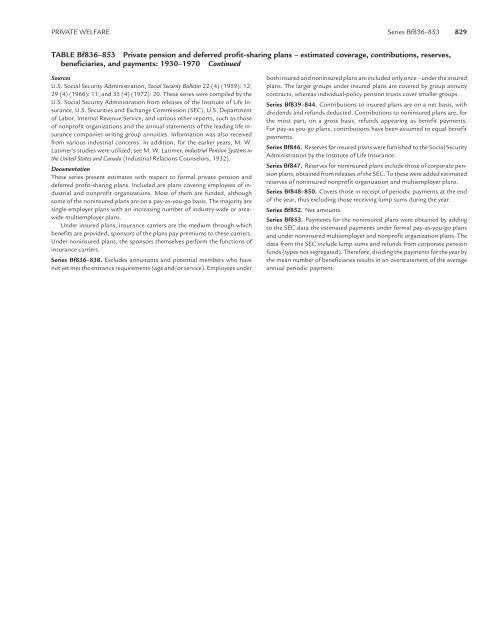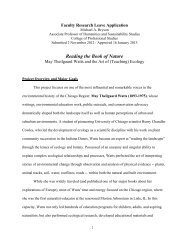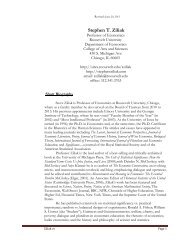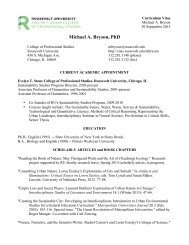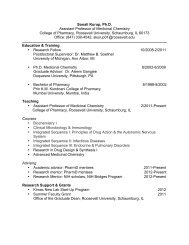Social Insurance and Public Assistance
public-assistance-welfare-reform-colonial-times-to-the-present-ziliak ...
public-assistance-welfare-reform-colonial-times-to-the-present-ziliak ...
You also want an ePaper? Increase the reach of your titles
YUMPU automatically turns print PDFs into web optimized ePapers that Google loves.
PRIVATE WELFARE Series Bf836–853 829<br />
TABLE Bf836–853 Private pension <strong>and</strong> deferred profit-sharing plans – estimated coverage, contributions, reserves,<br />
beneficiaries, <strong>and</strong> payments: 1930–1970 Continued<br />
Sources<br />
U.S. <strong>Social</strong> Security Administration, <strong>Social</strong> Security Bulletin 22 (4) (1959): 12;<br />
29 (4) (1966): 11; <strong>and</strong> 35 (4) (1972): 20. These series were compiled by the<br />
U.S. <strong>Social</strong> Security Administration from releases of the Institute of Life <strong>Insurance</strong>,<br />
U.S. Securities <strong>and</strong> Exchange Commission (SEC), U.S. Department<br />
of Labor, Internal Revenue Service, <strong>and</strong> various other reports, such as those<br />
of nonprofit organizations <strong>and</strong> the annual statements of the leading life insurance<br />
companies writing group annuities. Information was also received<br />
from various industrial concerns. In addition, for the earlier years, M. W.<br />
Latimer’s studies were utilized; see M. W. Latimer, Industrial Pension Systems in<br />
the United States <strong>and</strong> Canada (Industrial Relations Counselors, 1932).<br />
Documentation<br />
These series present estimates with respect to formal private pension <strong>and</strong><br />
deferred profit-sharing plans. Included are plans covering employees of industrial<br />
<strong>and</strong> nonprofit organizations. Most of them are funded, although<br />
some of the noninsured plans are on a pay-as-you-go basis. The majority are<br />
single-employer plans with an increasing number of industry-wide or areawide<br />
multiemployer plans.<br />
Under insured plans, insurance carriers are the medium through which<br />
benefits are provided; sponsors of the plans pay premiums to these carriers.<br />
Under noninsured plans, the sponsors themselves perform the functions of<br />
insurance carriers.<br />
Series Bf836–838. Excludes annuitants <strong>and</strong> potential members who have<br />
not yet met the entrance requirements (age <strong>and</strong>/or service). Employees under<br />
both insured <strong>and</strong> noninsured plans are included only once – under the insured<br />
plans. The larger groups under insured plans are covered by group annuity<br />
contracts, whereas individual-policy pension trusts cover smaller groups.<br />
Series Bf839–844. Contributions to insured plans are on a net basis, with<br />
dividends <strong>and</strong> refunds deducted. Contributions to noninsured plans are, for<br />
the most part, on a gross basis, refunds appearing as benefit payments.<br />
For pay-as you-go plans, contributions have been assumed to equal benefit<br />
payments.<br />
Series Bf846. Reserves for insured plans were furnished to the <strong>Social</strong> Security<br />
Administration by the Institute of Life <strong>Insurance</strong>.<br />
Series Bf847. Reserves for noninsured plans include those of corporate pension<br />
plans, obtained from releases of the SEC. To these were added estimated<br />
reserves of noninsured nonprofit organization <strong>and</strong> multiemployer plans.<br />
Series Bf848–850. Covers those in receipt of periodic payments at the end<br />
of the year, thus excluding those receiving lump sums during the year.<br />
Series Bf852. Net amounts.<br />
Series Bf853. Payments for the noninsured plans were obtained by adding<br />
to the SEC data the estimated payments under formal pay-as-you-go plans<br />
<strong>and</strong> under noninsured multiemployer <strong>and</strong> nonprofit organization plans. The<br />
data from the SEC include lump sums <strong>and</strong> refunds from corporate pension<br />
funds (types not segregated). Therefore, dividing the payments for the year by<br />
the mean number of beneficiaries results in an overstatement of the average<br />
annual periodic payment.


